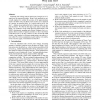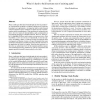1931 search results - page 58 / 387 » Why we blog |
SIGMOD
2009
ACM
14 years 9 months ago
2009
ACM
Many websites provide form-like interfaces which allow users to execute search queries on the underlying hidden databases. In this paper, we explain the importance of protecting s...
ICCAD
2008
IEEE
14 years 5 months ago
2008
IEEE
Statistical static timing analysis (SSTA) has emerged as an essential tool for nanoscale designs. Monte Carlo methods are universally employed to validate the accuracy of the appr...
CP
2009
Springer
14 years 3 months ago
2009
Springer
Abstract. The global cumulative constraint was proposed for modelling cumulative resources in scheduling problems for finite domain (FD) propagation. Since that time a great deal ...
ICSE
1995
IEEE-ACM
14 years 7 days ago
1995
IEEE-ACM
Many would argue that future breakthroughs in software productivity will dependon our ability to combine existing pieces of software to produce new applications. An important step...
CSCW
2008
ACM
13 years 10 months ago
2008
ACM
Google Maps and its spin-offs are highly successful, but they have a major limitation: users see only pictures of geographic data. These data are inaccessible except by limited ve...


